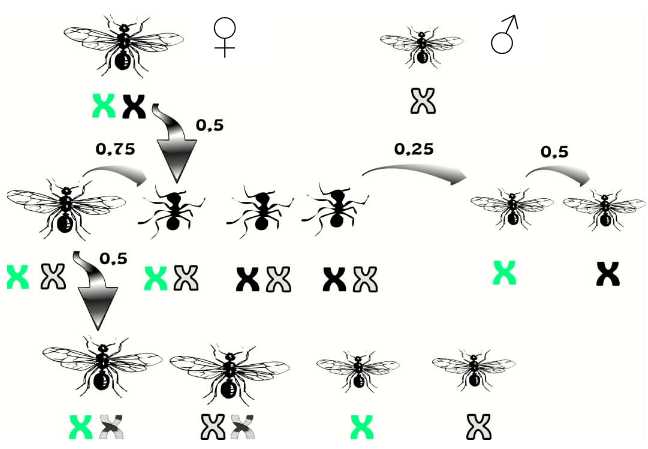IV.9.1.1 The development of social insects in Hymenoptera could be related to their haplodiploid system of genetic sex determination.
Social living habits are encountered in a great many groups of organisms.Eusociality, i.e. differentiation of individuals in the framework of social groups into a cast of reproducing individuals and casts of not reproducing individuals, which assist the reproducing individuals obtain various resources, is encountered primarily in hymenopterous insects.Eusociality apparently developed at least 11 times in this insect order, so that there are a number of mutually not very related groups of social insects (all ant pecies, a great many species of wasps and bees).Eusocial insectsfrequently live in very numerous colonies, in which only some individuals are capable of reproduction, while the rest form the sterile casts of workers or soldiers.These casts take care of the wellbeing of the colony and reproduction success of their mother, but their members do not usually reproduce.For a long time, it was not understood why so many social species occur for hymenopterous insects.

Fig. IV.12. The evolution of eusociality in haplodiploid insects. In diploid organisms, an allele on a female autosome has the same, i.e. 50%, chance that it will be located in the chromosomal set of randomly selected sisters as that it will be present in the chromosomal set of a randomly selected offspring. However, in haplodiploid species, such an allele has 75% chance of being present on the chromosome originally derived from the mother and 100% chance that it will be present on a chromosome originally derived from the (haploid) father. The probability that it will be present in the chromosomal set of any daughter remains equal to 50% in haplodiploid organisms. From the standpoint of reproduction of an allele located in the genome of a female, it is thus more advantageous if the female will assist her own mother to produce her sisters than if she reproduces herself. This fact is frequently considered to be an important pre-adaptation of haplodiploid species towards the establishment of eusociality, i.e. towards formation of casts of non-reproducing workers.
Representatives of insect order Hymenopteradiffer from the vast majority of other organisms in that these are haplodiploid organisms, i.e. organisms for which the sex of the individual is genetically determined by the ploidy level of the developing embryo.If the egg is not fertilized, a haploid male develops from it; if it is fertilized, a diploid female develops.As Hamilton showed in the 1960’s (Hamilton 1964a; Hamilton 1964b), this manner of determining sex has a very interesting consequence.In normal organisms, siblings are mutually related in the same way as parents with their progeny.The father and mother have two alleles of each gene and each zygote receives one allele of each gene from the mother and one from the father.Thus, the probability that two zygotes originating from the same parents will have a copy of the same allele at a certain locus is thus exactly 50%.The same probability of sharing alleles also exists between a parent and progeny, as exactly half of the alleles enter each zygote, one of two from each parent.
The situation is different in a haplodiploid organism (Fig. IV.12).Under ideal conditions, i.e., for example, assuming strict monogamy of the mother, any allele on a chromosome in the male has exactly 50% chance that its copy will be present in the genome of the descendant (100% certainty in a diploid daughter and 0% in a haploid son) and an allele on the chromosome of the female has exactly 50% chance that it will be present in the genome of any son or daughter.An allele on the chromosome of the male simultaneously has 50% chance that its copy will be present in the genome of any brother or sister.In contrast, an allele on a chromosome of a female has either 100% certainty that it will be in the genome of any sister and 0% certainty that it will be in the genome of any brother (if this is an allele derived from the father) or 50% certainty that it will be in the genome of any sibling (if it is derived from the mother).The mutual relationship between sisters is greater (75%) than between the mother and daughter (50%).From the standpoint of the allele located on chromosomes in the cells of a female, it is thus more advantageous to program the relevant vehicle, the bee, to assist her mother in producing her daughters (a greater percentage of the new vehicles will contain a copy of the relevant allele) than to reproduce herself.From the standpoint of the allele located on a chromosome of a cell of a male, both possibilities are equivalent.As the behaviour of the vehicles (the individual organisms) is entirely subservient to the interests of the genes that created and programmed them, it is probable in haplodiploid organisms that some of the daughters will give up on their own reproduction and, instead, assist their parents in producing sisters.
